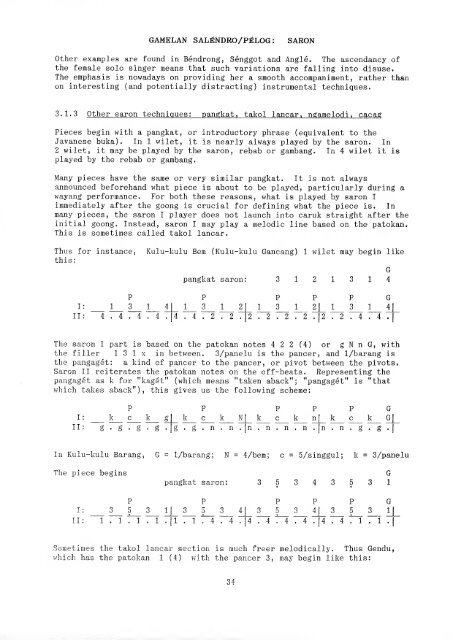Guide to Sundanese Music - Free EBooks Library
Guide to Sundanese Music - Free EBooks Library
Guide to Sundanese Music - Free EBooks Library
You also want an ePaper? Increase the reach of your titles
YUMPU automatically turns print PDFs into web optimized ePapers that Google loves.
GAMELAN SAL:gNDRO/P]gLOG : SARON<br />
Other examples are found in Bendrong, Senggot and Angle. The ascendancy of<br />
the female solo singer means that such variations are falling in<strong>to</strong> disuse.<br />
The emphasis is nowadays on providing her a smooth accompaniment, rather than<br />
on interesting (and potentially distracting) instrumental techniques.<br />
3.1.3 Other saron techniques: pangkat, takol lancar, ngamelodi, cacag<br />
Pieces begin with a pangkat, or introduc<strong>to</strong>ry phrase (equivalent <strong>to</strong> the<br />
Javanese buka). In 1 wilet, it is nearly always played by the saron. In<br />
2 wilet, it may be played by the saron, rebab or gambang. In 4 wilet it is<br />
played by the rebab or gambang.<br />
Many pieces have the same or very similar pangkat. It is not always<br />
announced beforehand what piece is about <strong>to</strong> be played, particularly during a<br />
wayang performance. For both these reasons, what is played by saron I<br />
immediately after the goong is crucial for defining what the piece is. In<br />
many pieces, the saron I player does not launch in<strong>to</strong> caruk straight after the<br />
Initial goong. Instead, saron I may play a melodic line based on the pa<strong>to</strong>kan.<br />
This is sometimes called takol lancar.<br />
Thus for instance, Kulu-kulu Bem (Kulu-kulu Gancang) 1 wilet may begin like<br />
this:<br />
G<br />
pangkat saron: 3 12 13 14<br />
I:<br />
P P<br />
1 3 1 41 1 3 1<br />
II: 4.4.4.4 2 .<br />
P P P G<br />
1 3 1 2| 1 3 1 4|<br />
2.2.2.2.12.2.4.4<br />
The saron I part is based on the pa<strong>to</strong>kan notes 422 (4) or gNnG, with<br />
the filler 1 3 1 x in between. 3/panelu is the pancer, and 1/barang is<br />
the pangaget: a kind of pancer <strong>to</strong> the pancer, or pivot between the pivots.<br />
Saron II reiterates the pa<strong>to</strong>kan notes on the off-beats. Representing the<br />
pangaget as k for "kaget" (which means "taken aback"; "pangaget" is "that<br />
which takes aback"), this gives us the following scheme:<br />
I:<br />
II:<br />
P<br />
k c N! k<br />
P<br />
c k<br />
n<br />
P<br />
c<br />
G<br />
k Gl<br />
In Kulu-kulu Barang, G = 1/barang; N = 4/bem; c = 5/singgul; k = 3/panelu<br />
The piece begins<br />
II: 1 . 1 . 1 . 1 . !1<br />
pangkat saron:<br />
P<br />
P<br />
5<br />
41<br />
5<br />
4.4.4.4.4.4.1<br />
Sometimes the takol lancar section is much freer melodically. Thus Gendu,<br />
which has the pa<strong>to</strong>kan 1 (4) with the pancer 3, may begin like this:<br />
34<br />
P<br />
G<br />
1<br />
1 .<br />
G<br />
11








